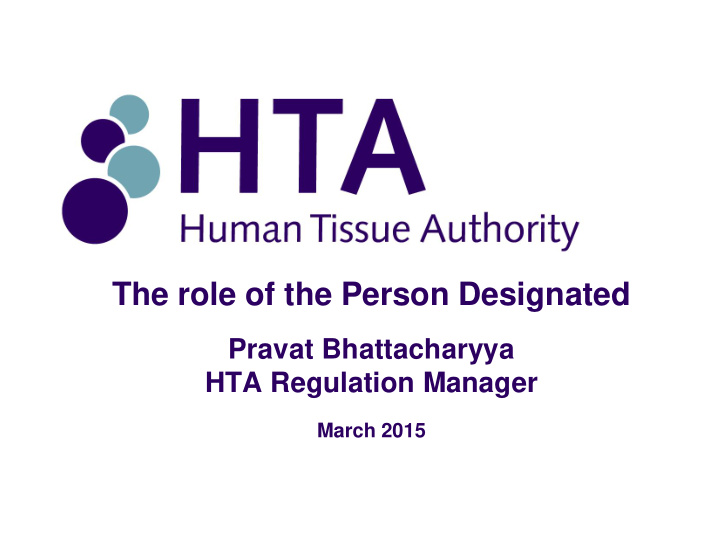



The role of the Person Designated Pravat Bhattacharyya HTA Regulation Manager March 2015
Overview of presentation The HTA Communication How PDs can Where PDs licensing between DIs and support a DI can be based framework PDs
HTA licensing framework Licence Holder Normally a corporate entity Named Corporate Licence Holder contact (CLHc) CLHc typically more senior to DI Designated Individual (DI) Statutory role in Human Tissue Act 2004 Persons Designated (PDs) Responsibilities not defined, as for DIs, in HT Act ‘Guide to Licensing for Designated Individuals and Licence Holders’
Suitability of the DI (s18 of HT Act) “ It shall be the duty of the individual designated in a licence as the person under whose supervision the licensed activity is authorised to be carried on to secure (a) that the other persons to whom the licence applies are suitable persons to participate in the carrying-on of the licensed activity, (b) that suitable practices are used in the course of carrying on that activity, and (c) that the conditions of the licence are complied with ”
The importance of PDs PDs can support a PDs can support a DI by DI by providing providing local oversight local oversight of of licensed activities licensed activities PDs can update A DI can a DI on nominate PDs activities in their to report a areas, bringing potential HTARI to their attention to HTA any concerns
How PDs can support a DI Contribute to quality management Carry out audits Write and review SOPs and risk assessments Train non-mortuary staff Cascade information to colleagues locally Report an HTARI within five working days if nominated to do so A DI should nominate as many PDs as they feel necessary for them to fulfil their statutory responsibilities under s18 of the HT Act Depending on scope of activities and size of organisation
Where do we expect to find PDs? Satellites Histopath lab Mortuary
Where can PDs also be useful? Storage areas for relevant material for use for scheduled purposes Research collections Education and training Existing holdings Accident and Emergency Removal of tissue samples from deceased infants Bereavement Services Seeking consent for PM examination Maternity Temporary storage of neonates en route to mortuary Consent for perinatal PM examination Operating theatres (where DI has responsibility for this) Removal of tissue samples from deceased persons for use for scheduled purposes
Communication Virtual meetings Email circulation PDs can attend, for example Conferences HTA training events Receive e-newsletters Regular governance meetings involving DI and PDs Cascade of information, including news from HTA Issues arising, including incidents and near misses How inspection findings are being addressed
At an HTA site visit inspection Confirm PDs are in place where licensable activities are being carried out Assure ourselves the risk of non-compliance is mitigated by the presence of a PD Check PDs awareness of HT Act, Codes HTARIs How DI and PDs communicate Formally / informally In case of an HTARI / near miss
Summary DI retains overall responsibility PDs can be a DI’s ‘eyes and ears’ in areas where licensable activities take place PDs can help a DI to ensure licensing standards are being met Inform us of changes to PDs on your licence New PDs / PDs leaving Email notification (licensing.enquiries@hta.gov.uk) Provide contact details and job title No charge! E-newsletter mailing
Recommend
More recommend